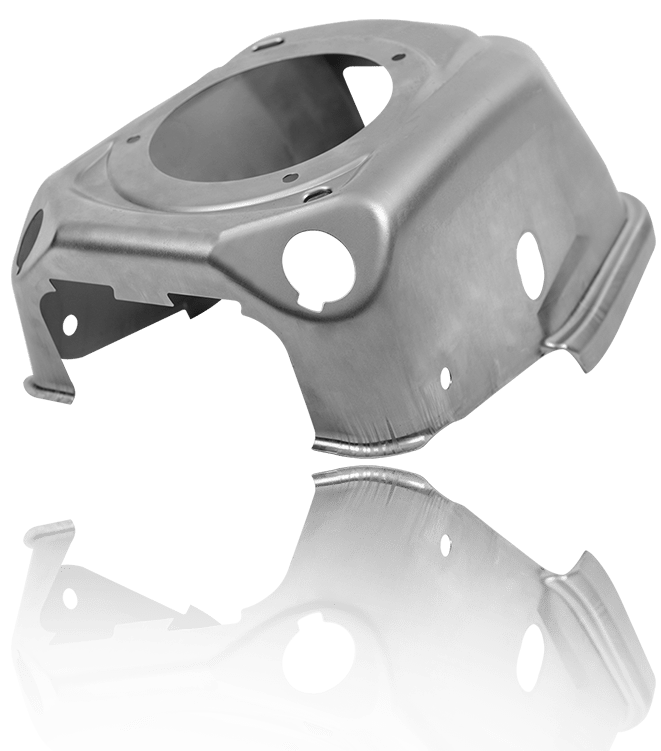Discover the current Advancements in Metal Stamping for Accuracy Production
Discover the current Advancements in Metal Stamping for Accuracy Production
Blog Article
The Evolution of Steel Stamping Procedures: Developments and Applications
The world of metal stamping processes has actually witnessed a transformative journey noted by constant advancement and adjustment to meet the demands of modern-day commercial practices. The applications extend throughout a spectrum of industries, each benefiting distinctively from the developments in steel stamping procedures.
Conventional Metal Marking Methods
Conventional steel marking methods have long been the foundation of making procedures in numerous markets as a result of their performance and accuracy. The process includes creating a steel sheet or coil right into a wanted form by pressing it between a die and a punch. This method is widely utilized for creating big quantities of parts with high accuracy at a fast speed.
One of the crucial benefits of typical steel stamping methods is the capability to preserve tight tolerances, guaranteeing that each part meets the required specifications continually. This degree of accuracy is necessary in sectors such as auto, aerospace, and electronic devices, where also small discrepancies can cause considerable issues.
Furthermore, traditional steel marking methods use economical options for mass production compared to other making techniques. The capability to stamp parts in fast sequence lessens manufacturing time and decreases labor costs, making it an attractive alternative for services seeking to optimize their production procedures.
Development of High-Speed Stamping

Among the essential benefits of high-speed stamping is its capability to preserve precision and uniformity also at sped up processing speeds. This precision is crucial in markets where limited tolerances and detailed designs are needed. In addition, high-speed stamping permits for the handling of a variety of materials, including light weight aluminum, stainless steel, and copper, additional increasing its applicability across various markets.
Furthermore, the development of high-speed marking has actually enabled makers to fulfill the growing demand for complicated parts in sectors such as automotive, aerospace, and electronics (Metal Stamping). By leveraging the speed and precision of high-speed marking modern technology, companies can improve their competition in a swiftly evolving market landscape
Developments in Tooling Innovation
With the advancement of high-speed stamping enabling enhanced precision and effectiveness in metal developing procedures, the area of steel marking has actually seen substantial advancements in tooling technology. Tooling technology plays a vital duty in steel marking operations, influencing elements such as product quality, production speed, and general cost-effectiveness. One crucial innovation in tooling technology is the development of intelligent tooling systems that incorporate sensing units and keeping track of devices to offer real-time data on the stamping process. These systems can spot problems such as tool wear or misalignment, permitting prompt changes to preserve ideal performance.
By using these innovative materials, tooling suppliers can generate Extra resources dies and molds that stand up to the high stress and temperatures involved in metal marking processes, resulting in longer tool life and enhanced manufacturing efficiency. In general, these improvements in tooling modern technology have actually changed the metal stamping industry, allowing producers to accomplish higher levels of precision, efficiency, and cost financial savings.
Integration of Automation in Marking
As automation proceeds to reshape the landscape of steel stamping procedures, the combination of automated systems has come to be progressively common in contemporary production centers. Automated systems use numerous benefits in steel marking, including enhanced effectiveness, boosted precision, and improved security. By integrating automation into stamping procedures, suppliers can lower cycle times, decrease product waste, and enhance production throughput.
Among the crucial elements of automation in marking is using robot arms for jobs such as material handling, component control, and quality assessment (Metal Stamping). These robotic systems can carry out repetitive and labor-intensive tasks with rate and accuracy, liberating human drivers to focus on even more complex procedures. Furthermore, automation enables real-time tracking and adjustment of marking processes, bring about higher total process control and quality control
In Discover More addition, the combination of automation in marking allows suppliers to accomplish regular part top quality, meet limited resistances, and enhance general productivity. As innovation remains to breakthrough, the function of automation in steel marking processes is anticipated to increase even more, driving advancement and efficiency in the manufacturing market.
Applications Throughout Diverse Industries
Incorporating metal marking procedures across diverse sectors showcases the flexibility and versatility of this production technique. From automobile to aerospace, electronic devices to clinical tools, metal stamping plays a critical role in the production of a large array of components. In the vehicle sector, steel marking is used to create complex components such as body panels, framework parts, and engine parts with high precision and effectiveness. The aerospace market depends on steel marking for producing light-weight yet sturdy parts for airplane and spacecraft. In the electronic devices sector, metal stamping is important for creating ports, get in touches with, and various other little get rid of limited resistances. Medical gadget makers use steel marking for producing exact elements like medical instruments and implants. Furthermore, the home appliance market take advantage of metal marking procedures to produce parts for refrigerators, washing equipments, and various other family home appliances. The versatility of metal marking procedures makes it a useful production method throughout different markets, showing its value in contemporary production processes.
Final Thought

Report this page